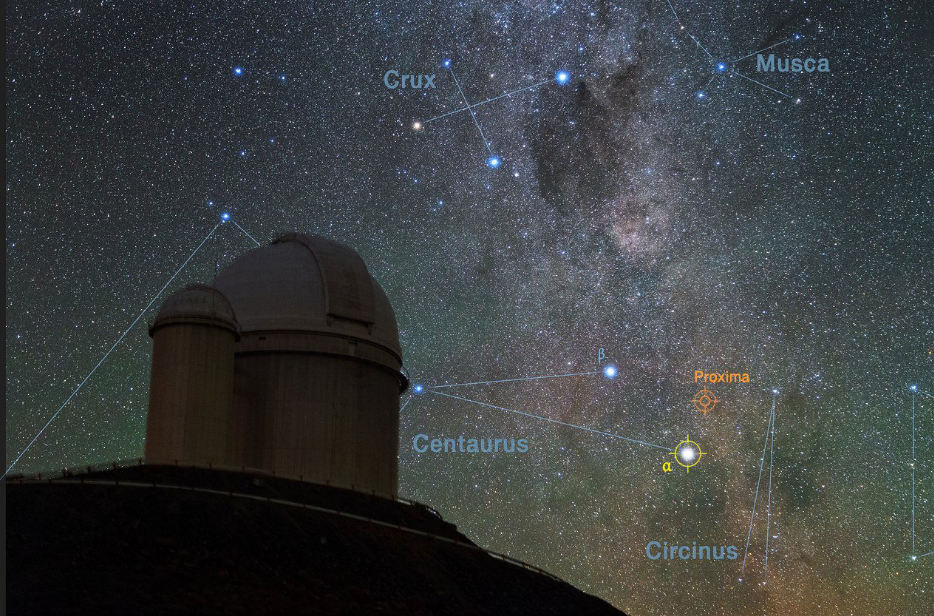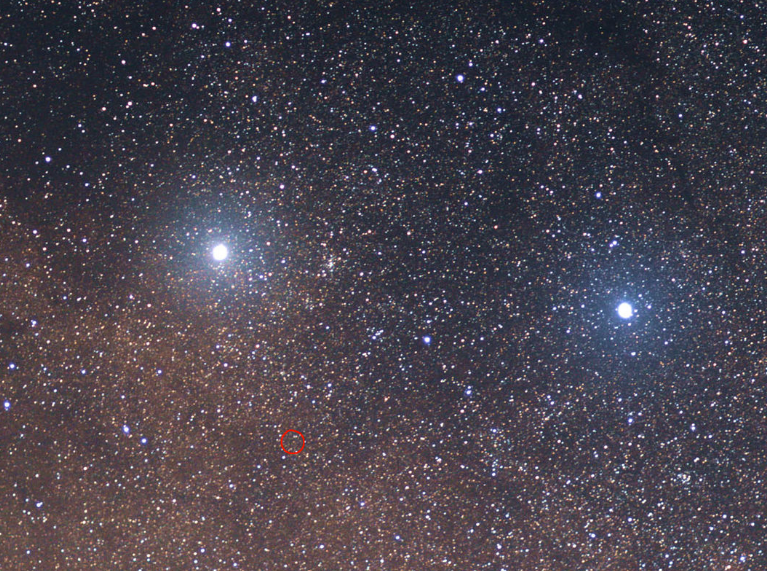A possible habitable planet is only four light-years away, astronomers discover
August 24, 2016

Artist’s impression shows a view of the surface of the planet Proxima b orbiting the red dwarf star Proxima Centauri, the closest star to the Solar System. The double star Alpha Centauri AB also appears in the image to the upper-right of the star Proxima. (credit: ESO/M. Kornmesser)
A rocky planet called Proxima b — the closest exoplanet to us — is in the habitable zone of Proxima Centauri, the closest star to our Solar System, a team of astronomers has found after painstaking observation and data analysis.
The new world orbits its cool red-dwarf parent star every 11.2 days and has a temperature suitable for liquid water to exist on its surface. A paper describing this milestone finding was published online today (Aug. 24) in the journal Nature.
The star Proxima Centauri, which is 4.2 light-years from Earth, in the constellation of Centaurus, is too faint to be seen with the naked eye and is close to the much brighter pair of stars known as Alpha Centauri A and B.

A view of the skies over the European Southern Observatory’s La Silla Observatory in Chile (credit: Y. Beletsky (LCO)/ESO/ESA/NASA/M. Zamani)
During the first half of 2016, the HARPS spectrograph on the European Southern Observatory’s 3.6-meter telescope at La Silla regularly observed the star Proxima Centauri, as did other professional and amateur telescopes around the world in a collaboration known as the Pale Red Dot campaign — looking for a tiny back-and-forth wobble in the star caused by the gravitational pull of an orbiting planet. (Other scientists have also been observing Proxima Centauri for years.)

The two bright stars are (left) Alpha Centauri and (right) Beta Centauri. The faint red star in the center of the red circle is Proxima Centauri. (credit: Skatebiker/CC)
So here’s what the Pale Red Dot data — when combined with earlier observations — shows:
- At regular intervals, the star Proxima Centauri is approaching Earth at about 5 kilometers per hour — normal human walking pace — and at opposite times in those cycles it is receding at the same speed. This regular pattern repeats with a period of 11.2 days.
- Analysis of the resulting Doppler shifts (and removing brightness-variation artifacts from the star) indicated the presence of a planet with a mass at least 1.3 times that of the Earth, orbiting about 7 million kilometers from Proxima Centauri (about 5 percent of the distance of Earth for our Sun, and coser than the planet Mercury is to our Sun — but Proxima Centauri is cooler than our Sun).
- Proxima b is tidally locked to its star (one side is always sunny, the other is dark) and has an estimated temperature that would allow for a liquid state on its surface, thus placing it within the “habitable zone” around the star (assuming water is present). Atmosphere: unknown.
- Proxima may be strongly affected by ultraviolet and x-ray flares from the star — far more intense than the Earth experiences from the Sun. (Extreme sun glasses recommended if you visit.)
Meanwhile a wild project by Stephen Hawking and philanthropist Yuri Milner — who announced in April a $100 million research and engineering program, Breakthrough Starshot, to study the concept of using laser light beams to propel gram-scale “nanocraft” to 20 percent of light speed to travel to Alpha Centauri — (KurzweilAI: Breakthrough Starshot’ aims to reach Alpha Centauri 20 years after launch) has been vindicated — with a minor detour.
Abstract of A terrestrial planet candidate in a temperate orbit around Proxima Centauri
At a distance of 1.295 parsecs, the red dwarf Proxima Centauri (α Centauri C, GL 551, HIP 70890 or simply Proxima) is the Sun’s closest stellar neighbour and one of the best-studied low-mass stars. It has an effective temperature of only around 3,050 kelvin, a luminosity of 0.15 per cent of that of the Sun, a measured radius of 14 per cent of the radius of the Sun and a mass of about 12 per cent of the mass of the Sun. Although Proxima is considered a moderately active star, its rotation period is about 83 days and its quiescent activity levels and X-ray luminosity are comparable to those of the Sun. Here we report observations that reveal the presence of a small planet with a minimum mass of about 1.3 Earth masses orbiting Proxima with a period of approximately 11.2 days at a semi-major-axis distance of around 0.05 astronomical units. Its equilibrium temperature is within the range where water could be liquid on its surface.